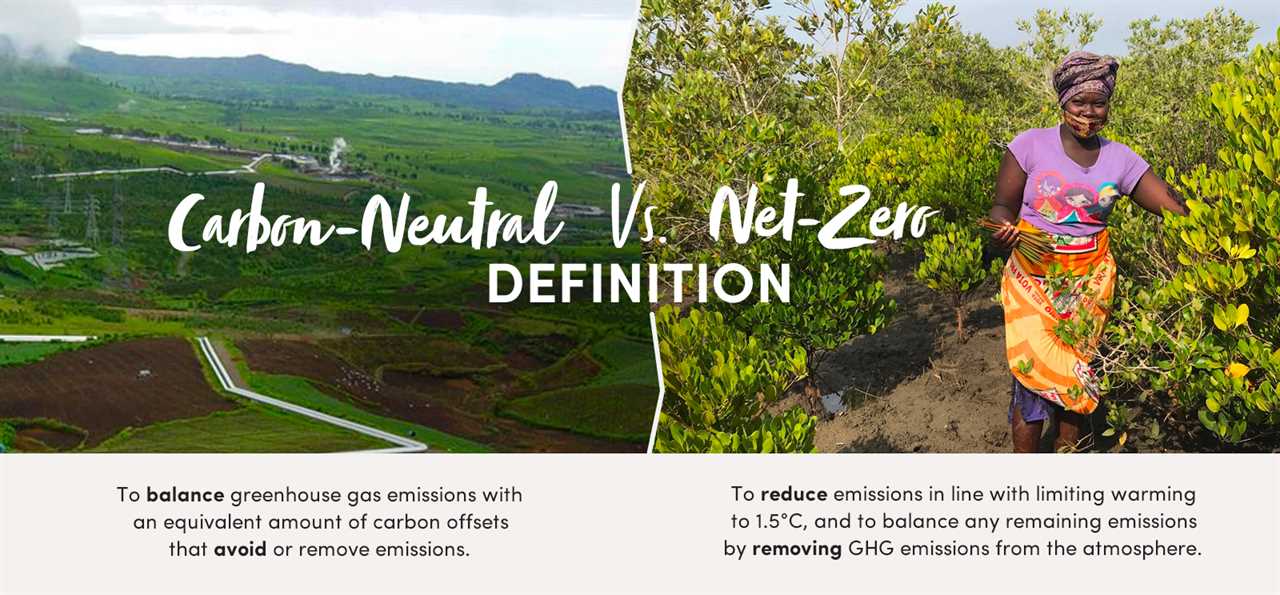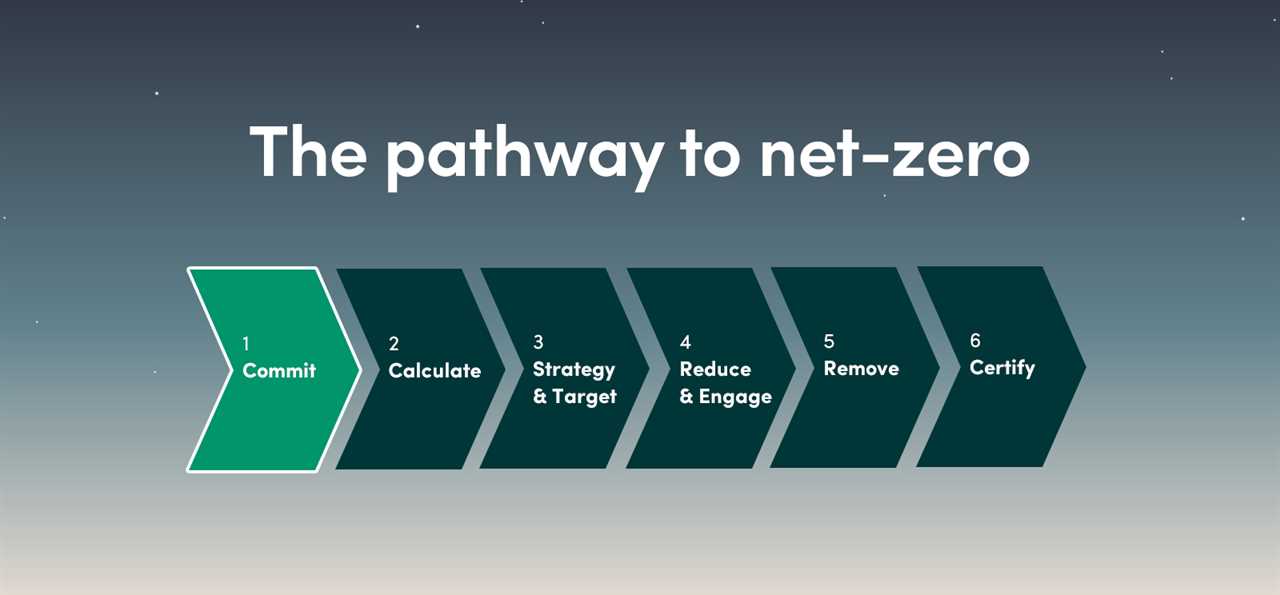
Carbon neutral vs net-zero
Much of the confusion stems from the fact that, until recently, there was no universally accepted definition of the term. While carbon neutrality and net-zero are both rooted in balancing human-induced (anthropogenic) emissions, the paths to achieving them are very different. You can check out our blog with more detail on the differences between carbon-neutral and net-zero, and hear why at Ecologi we recommend following a net-zero pathway, and not a carbon neutral one.
Clearing up the confusion with the SBTi Net-Zero Standard
With a robust framework grounded in climate science, business leaders can now confidently set emissions reduction targets in line with the Paris Agreement and take the climate action necessary to limit global temperature rise to 1.5°C.
Under the SBTi Net-Zero Standard, corporate net-zero is defined as:
- Reducing scope 1, 2, and 3 emissions to zero or to a residual level that is consistent with reaching net-zero emissions at the global or sector level in eligible 1.5°C-aligned pathways
- Neutralising any residual emissions at the net-zero target year and any GHG emissions released into the atmosphere thereafter.
The key elements of corporate net-zero
- Near-Term Science-Based Targets – not interchangeable with long-term targets, near-term targets galvanise action and initiate change to make sure that businesses can achieve rapid and significant reductions in emissions (typically 4.2% p.a*) by 2030, in line with climate science.
- Long-Term Science-Based Targets – determine how much a company must reduce their value chain emissions to align with limiting warming to 1.5°C. A company cannot claim to be net-zero until the long-term science-based target has been reached (90% reduction in emissions*). The deadline for long-term targets is 2050, but more ambitious companies are striving to reach net-zero before this.
- Beyond Value Chain Mitigation – The SBTi encourages companies to take action and fund projects with climate benefits beyond their value chain. This will help to mitigate GHG emissions and lead to additional benefits for people and the planet in support of the UN’s Sustainable Development Goals. Beyond value chain mitigation should supplement, rather than replace, a comprehensive decarbonisation strategy – and it can include, for example, funding carbon avoidance or removal projects, nature restoration schemes, research and development, new technologies, and supporting environmental legal defence (amongst others). As a result of funding carbon removal or avoidance projects, a company may become ‘carbon neutral’. However, this is not the end goal, and emissions reduction should be prioritised.
- Neutralisation – The SBTi acknowledges that it may not be feasible for some industries to achieve zero emissions and decarbonise 100% of the value chain. As a result, once long-term decarbonisation targets have been reached, companies must use carbon removals to neutralise unavoidable emissions (which must not exceed 10% of overall company emissions against the base year).
* Targets and required reduction varies across industries. Please refer to the SBTi Net-Zero standard for clarification.

A six-stage path to achieving net-zero
- Commit – There must be an acknowledgement that your business can be part of the solution and needs to change. Net-zero doesn’t happen overnight, it’s a transition that needs a long-term commitment. It requires systematic processes and structural changes across the entire value chain. So the relevant internal stakeholders need to understand the reasons for change and buy into the process.
- Calculate – Calculation is key to understanding your starting point, identifying emission hotspots in your value chain and seeing the greatest opportunities for reduction. This stage is repeated throughout your journey to net-zero (typically on an annual basis) to measure performance against your targets and the impact of your reduction strategies.
- Strategy and Target Setting – Once you’ve measured your emissions and established a starting point, you can begin to analyse your footprint and identify a suitable transition strategy to decarbonise your operations. Strategy and target setting should be done in unison. There is little point in setting targets if you don’t know how to achieve them. Every business is unique, and what may be a suitable target for one business may be unrealistic for another. By developing a strategy alongside targets, you can assess their feasibility. Likewise, science-based targets complement strategy as they guide your level of ambition, hold you accountable and provide a measurable indicator of success.
- Reduce and Engage – Once a strategy has been established, it is essential to start implementing the plan by following a logical and achievable set of steps. This is not an overnight process and must also align with your business environment to be economically sustainable. Working with your supply chain is essential, as for many businesses up to 90% of emissions can come from the value chain. While this makes things more challenging, there are steps that you can take to support sustainable procurement and reduce your indirect emissions. *We intend to run further workshops and provide tools to support you in achieving this.
- Remove – The penultimate stage of net-zero occurs after significant reduction has been achieved, and it’s the removal of unavoidable emissions through buying and retiring carbon removal credits. Under the SBTI Net-Zero Standard, only up to 10% of your overall emissions against the base year can be removed in this way. You can only become certified as net-zero if using carbon removal credits as opposed to avoidance credits. You may, however, use carbon avoidance credits throughout your journey to becoming net-zero, to offset your emissions while implementing emissions reductions to achieve carbon neutrality. It should be emphasised that carbon neutrality is a stepping stone to net-zero and is a supplementary action to mitigate the effects of your current emissions. Net-zero should remain your long-term goal.
- Certify – Once you’ve taken action to reduce your emissions and potentially become carbon neutral, you will return to the calculation stage to assess the difference your changes have made, then re-evaluate your strategy and next steps. You will likely have to go through this cycle a number of times before you have achieved the required level of emissions reductions and transitioned to a state of net-zero. Then it’s time to really celebrate, as you can be certified as net-zero under the SBTi.
Crucially, whilst undertaking their net-zero journey businesses need to begin to prioritise people and planet, rather than just profit. This pathway, and the knowledge it requires may seem daunting. But we’ve been working hard behind the scenes to simplify the process by developing our very own carbon accounting tool. Ecologi Zero has been designed to remove the barriers that prevent small and medium-sized enterprises (SMEs) from starting their net-zero journey.
Ecologi Zero lets you calculate and analyse your footprint for free, using simple interactive dashboards. We also plan to introduce new features in the coming months, to support you through strategy development, target-setting and emissions reduction. Plus, you’ll soon also be able to support beyond value chain mitigation and carbon avoidance projects through Ecologi’s Impact Shop.
Find out more about Ecologi Zero and start your net-zero journey
By George Gibson, Ecologi
Ecologi will be exhibiting at Accountex London on the 10-11 of May 2023.
You can register for a free ticket here.
The post Charting the path to net-zero for businesses appeared first on Accounting Insight News.
------------Read More
By: George Gibson, Ecologi
Title: Charting the path to net-zero for businesses
Sourced From: www.accountex.co.uk/insight/2023/04/05/charting-the-path-to-net-zero-for-businesses/
Published Date: Wed, 05 Apr 2023 09:36:13 +0000
Did you miss our previous article...
https://trendinginbusiness.business/finance/how-to-map-your-stakeholder-relationships
.png)





